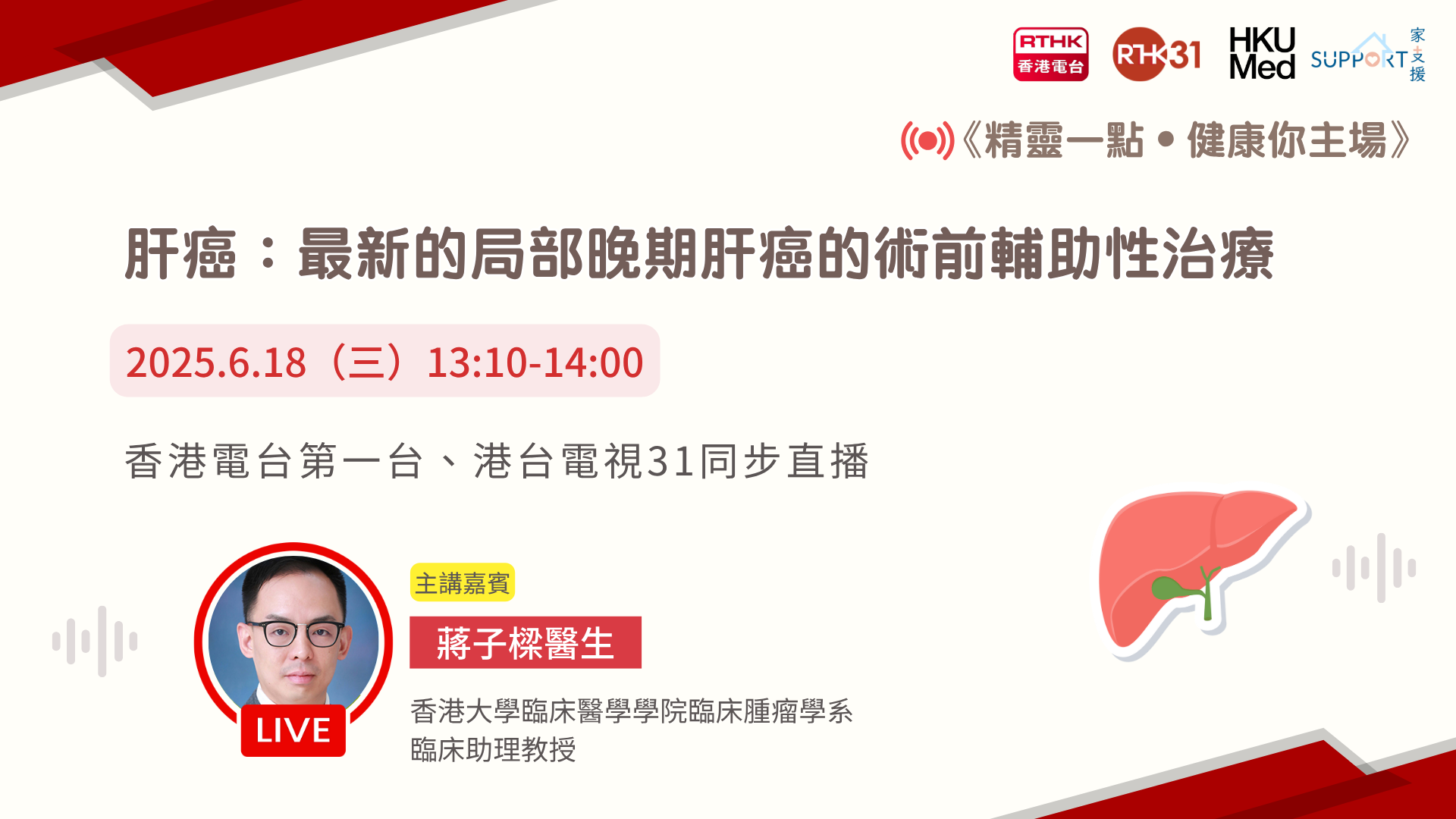肝癌
引言
肝癌是香港第五常見的癌症。2022年,肝癌新症共有1,612宗,佔本港癌症新症總數的4.6%,患肝癌的病人以男性為主,男性和女性的比例於2022年約為2.7比1。每10萬人口中即有22宗新增個案。過去十年(2012-2022),肝癌新症宗數下降了9.9%。
肝癌亦是本港第三致命的癌症,於2022年導致1,412人死亡,佔癌症死亡總數19.2%。
由於患者發現患上肝癌時多已屆癌症中晚期,故治療肝癌相對困難。因此,預防勝於治療,市民應接受乙型肝炎疫苗注射。此外,乙型肝炎病毒攜帶者更應定期跟進檢查,及早察覺肝臟腫瘤。
什麼是肝癌?
肝臟是人體非常重要的代謝器官。肝臟位於右上腹,分為左右兩葉。肝臟的主要功能包括:
- 生產及儲存血糖
- 製造膽汁,消化食物中的脂肪
- 具解毒功能,能分解身體內的毒素和酒精,然後排出體外
- 製造蛋白質、血凝素、抗體、膽固醇等身體必需的物質
當肝臟細胞出現異變及不停分裂,就會形成肝癌。肝癌大致可分為:
- 肝細胞癌(Hepatocellular Carcinoma, HCC),由肝臟細胞引發的惡性腫瘤
- 膽管癌(Bile Duct Cancer or Cholangiocarcinoma),膽管壁細胞的癌變
高危因素

- 乙型肝炎(Hepatitis B)
- 慢性乙肝病毒帶病毒者比非帶病毒者患上肝癌的機會高出約100倍
- 全世界55%的肝癌個案由乙肝病毒傳染引致
- 乙型肝炎在香港十分普遍。據估計,全港十分之一人口皆為帶病毒者或曾感染乙型肝炎,四分之一長期帶病毒者的病情會演變成肝硬化,並導致肝癌。
- 由感染乙型肝炎病毒演變至肝癌約需50至60年的時間
- 丙型肝炎(Hepatitis C)
- 丙型肝炎帶病毒者患肝癌的機會比非帶病毒者高約150倍。因丙型肝炎而患肝癌者於西方國家較常見。
- 肝硬化(Cirrhosis of the liver)
- 乙型肝炎患者或會出現慢性肝炎,並有機會演變成肝硬化和肝癌,病情的發展因肝炎病毒的活躍程度而異。
- 病毒活躍性越高,肝細胞被破壞的速度越快,演變成肝硬化或肝癌的機會越大。
- 酗酒
- 長期過量飲酒會引致肝硬化,並有機會逐漸演變成肝癌。
- 濫用酒精的乙型肝炎帶菌者患肝癌的機會比一般帶病毒者高出兩倍。
- 非酒精性脂肪性肝病 (Non-alcoholic Fatty Liver Disease)和非酒精性脂肪肝 ( Non-alcoholic Hepatosteatosis,NASH)
- 肥胖、糖尿病及其他代謝紊亂疾病均會使肝臟受損,從而導致肝硬化及肝癌。
- 長期攝入黃曲霉毒素(Chronic consumption of aflatoxins)
- 由花生、玉米、堅果和穀物發霉產生的黃曲霉毒素可導致肝癌。
- 長期接觸工業和環境污染物
- 長期吸入有害化學物質,如塑膠廠使用的聚氯乙烯(PolyVinyl Chloride,PVC)可致癌。
- 膽管炎(膽管發炎)或先天性膽總管囊腫(Cholangitis (inflamed bile duct) or congenital choledochal cysts)
- 可引致膽管細胞癌
- 寄生蟲(Parasites)
- 肝吸蟲會引致慢性膽囊和肝臟感染,從而演變成肝癌。
病徵
- 右上腹不適、腹痛,右肩或背部疼痛
- 食慾不振、體重下降
- 發燒, 或會出現寒顫
- 右肋骨下方有硬塊,可能因為腫瘤或肝臟變大
- 疲倦昏睡
- 皮膚或眼白泛黃、皮膚痕癢
- 小便呈茶色、大便呈淺灰色
- 腹部積水,有時於腹部表面可見靜脈青筋
- 易受傷出血
- 噁心嘔吐

診斷
驗血(Blood test)
- 甲胎蛋白(Alpha Fetoprotein,AFP)
- 肝癌細胞的腫瘤標記,常用以為高風險肝病患者(肝硬化、慢性乙肝、丙肝患者)作肝癌篩查。
- 也可用於預測肝癌的發展、監測治療成效及檢測肝癌復發。
- 肝功能測試(Liver Function Test)
- 檢查肝臟是否能正常運作, 以決定對患者的後續治療。
肝臟超聲波(Ultrasound of the liver)
- 利用超聲波檢查肝臟結構,以確認腫瘤的大小和位置。
- 利用超聲波可引導肝臟活組織切片檢查。
- 醫生會於患者近肝臟的皮膚表面塗上潤滑凝膠,然後以聲波儀探測。反彈的聲波會即時經電腦轉換成影像,讓醫生從螢幕觀察肝臟 。 肝臟超聲波無痛、無輻射,且全程只需十多分鐘。
電腦掃描(CT Scan)
- 可為肝臟拍攝不同角度的X光片,用電腦構成立體影像。
- 可顯示腫瘤的大小和位置。
磁力共振掃描(MRI)
- 與電腦掃描相似,但以磁場代替X 光形成身體橫截面的影像。
正電子掃描(PET Scan)
- 觀察癌細胞的位置及有否擴散其他器官。
- 當正電子掃描與電腦掃描合併使用,此稱為正電子電腦掃描(PET/CT Scan)。
血管造影(Angiogram)
- 患者需注射顯影劑,然後接受 X 光檢查。
- 用以觀察血流,以確認腫瘤及供應腫瘤養分的血管的位置。
腹腔鏡(Laparoscopy)
- 患者在全身麻醉下接受的微創手術,能讓醫生直接觀察肝臟。
- 醫生會於患者腹部造一個小口,然後把前端帶有射燈和攝影機的腹腔鏡軟管伸入檢查部位,以偵測腫瘤位置、形態和大小,從而判斷切除腫瘤的風險。腹腔鏡亦有助於抽取活組織作化驗。有時候,患者會同時進行超聲波掃描(Ultrasound)。
- 如腫瘤適合切除,醫生會以小型手術刀切除小塊組織。
肝臟活組織檢查(Liver Biopsy)
- 患者在局部麻醉下,醫生會使用一根細小的針,穿過右腹皮膚,抽取肝臟腫瘤組織。
- 通過超聲波的協助,令醫生找到插針的最佳位置。
- 抽取組織後,醫生會透過顯微鏡觀察細胞樣本,以判斷腫瘤類型及癌症期數。
種類
肝臟的惡性腫瘤有兩種:原發性和轉移性
- 原發性腫瘤
- 原發性腫瘤是由肝臟細胞發生癌變造成的。
- 原發性腫瘤可以再細分為肝癌(Hepatocellular carcinoma, HCC)、膽管癌和血管肉瘤。
- 肝癌(HCC)
- 肝癌是最常見的肝臟癌症,佔原發肝癌病例的75%
- 肝癌從肝細胞癌變而成
- 一般來說,肝癌大多只停留在肝臟,但仍有機會能擴散至其他器官。
- 膽管癌
- 膽管癌佔原發肝癌病例的10-20%
- 膽管是連接肝臟和小腸的管道,膽管癌從膽管細胞病變而成。
- 血管肉瘤
- 血管肉瘤佔原發肝癌病例的1%
- 血管肉瘤從肝臟的血管細胞病變而成,並會急速生長。
- 轉移性腫瘤
- 轉移性腫瘤指癌症由身體其他器官擴散至肝臟的癌症
- 幾乎所有癌症都有機會擴散至肝臟,最常見的是胰臟癌、胃癌、腸癌、乳癌和肺癌。
**這個章節中只重點說明「肝癌」(HCC)。
分期
臨床上採用「巴塞隆拿肝癌分期系統」( Barcelona Clinic Liver Cancer classification,BCLC),根據患者的肝功能、健康狀況和肝癌腫瘤性質為肝癌分期和制定治療方案。

治療
醫生制定治療方案時會考慮以下因素:
- 肝癌是原發性或繼發性
- 患者的年齡
- 患者的健康狀況
- 癌細胞的類型及 腫瘤的大小
- 癌細胞是否擴散
- 肝臟是否受到其他疾病的影響,例如肝炎、 肝硬化
若患者於早期發現腫瘤且肝功能正常,治療目的為消除癌細胞及根治癌症。若確診時已屆肝癌晚期,或患者肝臟功能不佳,治療目的則是控制癌細胞的生長和紓緩症狀。
治療早期肝癌
疾病導向治療
腫瘤位於肝臟且未擴散到其他部位時,醫生大多採用手術、射頻消融、皮下酒精注射和放射治療。
手術切除是治療早期肝癌的最佳選擇。若患者患有合併症或因肝功能低而不宜接受手術,醫生則會採用疾病導向治療,例如射頻消融治療或放射治療。
1. 手術
- 治療原理是通過手術切除腫瘤及附近受影響的組織。根治性手術切除適用於腫瘤只影響一邊的肝葉而肝功能正常的患者,佔肝癌患者約兩成。接受手術治療的患者三年及五年的生存率分別為62%及50%。
- 手術切除只限於肝功能良好的患者,以腫瘤分佈小為佳。
以下情況進行手術切除最為有效:
- 肝臟功能正常
- 腫瘤尚未擴散到血管,能安全地移除部分肝臟
以下情況不適合進行手術切除:
- 腫瘤擴散到肝臟多處
- 肝臟嚴重受損,例如嚴重硬化
- 腫瘤已擴散到肝臟外
- 患者患有其他嚴重疾病
以下兩種類型的手術適用於治療肝細胞癌(HCC):
- 部分肝臟切除術
- 僅切除部分肝臟。適用於腫瘤只影響肝臟局部、且肝臟其餘部分功能正常的患者。有些患者會在進行手術時,同時接受腫瘤或肝臟消融治療。
- 部分肝臟切除術後,肝臟的剩餘部分會繼續維持整個器官的運作。 肝臟可能會在幾週內恢復到正常大小。
- 如果患者患有晚期肝硬化,即使腫瘤細小也可能不適合接受部分肝臟切除術。
- 肝切除術的副作用包括疼痛、虛弱、疲倦和暫時性肝衰竭。
- 肝臟移植
- 肝臟移植可用於取替整個或一部分的肝臟。
- 對腫瘤較小的患者效果較好,因手術把腫瘤及受影響的肝臟部分切除。誠然,器官捐贈者頗少,故患者一般需輪侯多時。
- 接受肝臟移植需滿足以下條件:
- 單發腫瘤,直徑小於或等於 5 厘米;或兩至三個且直徑小於 3 厘米的腫瘤。
- 找到合適的捐贈者
- 肝移植後,醫生會密切觀察患者是否有器官排斥或腫瘤復發的跡象。患者必需服用防止排斥的藥物。這些藥物可能導致副作用,例如面部浮腫、高血壓或體毛增加。
- 其他嚴重併發症包括因感染而死亡、器官排斥和增加患上其他癌症的風險。
2. 其他治療方式
- 射頻消融治療(Radiofrequency Ablation,RFA)
- 利用超聲波掃描(Ultrasound)確定腫瘤位置,再利用射頻消融進行局部加熱,使腫瘤組織壞死。
- 可經皮膚穿刺、腹腔鏡或使用麻酸藥,在開腹手術下進行射頻消融治療。
- 射頻消融治療可用於肝癌或其他癌症但擴散至肝臟的患者。
- 適用於 5 厘米以下的腫瘤。由於消融治療通常會破壞腫瘤附近的正常組織,所以未必適合治療鄰近主要血管、橫隔膜或主要膽管的腫瘤。
- 需時約20 分鐘至 2 小時,時長視乎腫瘤的大小和數量。
- 副作用包括肝臟輕度腫脹、出血、感染和損害周圍器官(腸道、胃部)。
- 經皮酒精注射(Percutaneous Ethanol Injection,PEI)
- 利用超聲波掃描(Ultrasound)確定腫瘤位置,再以細針將酒精直 接注入腫瘤。酒精會吸乾細胞的水份,致癌細胞死亡。
- 若腫瘤再次生長,可重複療程。
- 經皮酒精注射簡單而安全,對小於 3 厘米的腫瘤或腫瘤顆數小於 3 個的原發性腫瘤尤為有效。但是,如果酒精從肝臟中溢出,便會令患者感到短暫而劇烈的疼痛。因此,醫生常以射頻治療 (Radiofrequency Ablation,RFA)取替。
- 副作用包括發燒、出血、膽管炎症及膽管滲漏。
- 高強度聚焦超聲波治療(High-Intensity Focused Ultrasound, HIFU)
- 醫生利用超聲治療轉換器從體外發射高強度超聲波,聚焦至患者體 內的腫瘤,累積的能量會令粒子擺動,從而產生高溫令癌細胞壞死。
- 與其他消融治療不同,此療程無需使用探針穿刺腫瘤,因此沒有出血或腫瘤細胞散播的風險。
- 對小於 3 厘米的腫瘤最有效。
- 副作用包括治療部位的皮膚輕微泛紅不適、肝壞死、肝衰竭及損害附近組織(腸道、胃部)受損。
- 選擇性體內放射治療(Selective Internal Radiation Therapy,SIRT)/ 放射性栓塞治療(Radioembolisation)
- 選擇性體內放射治療是一種結合栓塞術和放射治療,針對肝臟腫瘤,注射大量帶有放射性同位素釔-90(Y-90)的微粒。
- 選擇性體內放射治療適用於原發性肝癌或繼發性肝腫瘤。
- 治療前,醫生會先利用血管造影定位,分辨出供應養份至腫瘤的血管位置及把血液帶離肝臟或其他器官,如肺部的血管位置;然後由 放射科醫生決定患者是否適合接受此療程。
- 治療過程中,醫生會在患者的腹股溝處開一個小切口,然後將一根軟導管透過切口插入股動脈,放射科醫生會進行介入放射治療,把導管引進至肝動脈以注射放射性微粒到腫瘤。放射性微粒會先進入並停留在腫瘤裡面和附近的微血管中,釋放高劑量輻射,發揮局部 放射療效,針對性地殺死肝腫瘤,減低對正常肝臟組織的損害。注入放射性微粒大約需要 15 分鐘,整個過程則需要約一小時。
- 副作用包括疼痛、出血、發燒,且輻射可能導致胃部、小腸或胰臟潰瘍或發炎。
- 肝動脈化學栓塞術(Transarterial Chemoembolization,TACE)
- 肝動脈化療栓塞術結合肝動脈栓塞及化療。
- 肝動脈化療栓塞術適用於因腫瘤較大(通常直徑大於 5 厘米)、位置、數量或肝臟功能受損而不能使用手術或消融治療,但仍有相當的肝臟功能可以接受肝動脈化療栓塞術的患者。患者可同時接受消融治療。
- 肝動脈化療栓塞術可用於原發性肝癌或繼發性肝腫瘤的患者。
- 患者會在醫院的放射部門接受治療。接受局部麻醉後,醫生會於患者大腿內側切一個小口,經股動脈置入軟導管,並向上推送到肝動脈。經導管向肝動脈注射造影劑再進行 X 光掃描,以在影像上顯示向腫瘤輸送血液的血管。
- 確認為腫瘤供應血液的動脈後,醫生會將化療藥物--Doxorubicin (阿黴素)或 Cisplatin(順鉑)經過導管注入腫瘤,同時栓塞血管,以阻止養分輸送並導致腫瘤死亡。
- 副作用包括發燒、疼痛、噁心嘔吐、疲倦、肝功能受損、膽囊炎或膽管炎、肝衰竭(尤其是晚期肝硬化患者)。
- 立體定位放射治療(Stereotactic Body Radiation Therapy,SBRT)
- 立體定位放射治療是一種體外放射治療,能將高劑量輻射射線精準地發射至肝臟腫瘤;既可有效控制病情,也能盡量減少對正常組織的副作用。
- 立體定位放射治療可用於不適宜接受手術或局部消融治療、曾多次接受肝動脈化療栓塞術後復發、或因門靜脈血栓而不適宜接受肝動脈化療栓塞術的患者。
- 療程包含 3-5 次治療,並在 1-2 週內完成。相比之下,常規的體外放射治療需每天接受治療,為期數週。
- 進行治療前,醫生會製作模具,以在治療時固定患者。其後,醫生會利用電腦掃描(CT scan)計劃放射治療。磁力共振(MRI)能提供更清晰的腫瘤影像,有助醫生更精準地辨別腫瘤的大小及位置。
- 治療過程中,腫瘤有機會隨呼吸移動。因此,醫生會在患者腹部放置探測器,以監測患者的呼吸模式,減低放射射線對附近正常組織的影響。
- 副作用包括疼痛、疲倦、肝功能受損、腸胃或膽管損傷和肋骨骨折。
晚期肝癌的全身性治療
如果肝癌細胞已擴散到身體其他部位,而不適合使用以上的局部治療,則需採取全身性治療控制病情。適用於晚期肝癌患者的藥物有免疫治療和標靶治療。
免疫治療
- 例如:Atezolizumab(阿替利珠單抗)、Nivolumab(尼伏人單抗)、 Pembrolizumab(匹博利組單抗)、Ipilimumab(伊匹木單抗)、 Durvalumab(度伏尼尤)、Tremelimumab(替西木單抗)、 Tislelizumab(替雷利珠單抗)、Dostarlimab(多達利單抗)
- Atezolizumab (阿替利組單抗)和 Bevacizumab(貝伏珠單抗)
- Atezolizumab 和 Bevacizumab(一種抑制腫瘤血管生長的靶向藥物)的組合是無法切除或轉移性肝癌患者的一線治療。
- Durvalumab 和 Tremelimumab(雙免疫療法)的組合已被證實可作為無法切除之肝細胞癌患者的第一線治療。
- 如果患者在接受標靶治療後病情轉差,可考慮使用 Pembrolizumab、Nivolumab、合拼使用 NivolumabIpilimumab 或 Dostarlimab [只適用於高度微衛星不穩定 (Microsatellite instability-high,MSI-H)或錯配修復發生缺陷 (mismatch repair-deficient,dMMR)的腫瘤]。
- 副作用包括高血壓、發燒、肝酵素升高、蛋白尿及疲倦。
- 不常見但嚴重的副作用包括注輸後敏感反應(發燒、發冷、臉紅、 皮疹、皮膚痕癢、暈眩、氣喘及呼吸困難),荷爾蒙失調、免疫系統反應(肺部、腸道、肝臟、製造荷爾蒙的腺體、腎臟、皮膚或其他器官出現嚴重甚至致命副作用)。
標靶治療
- 例如:Lenvatinib(樂伏替尼)、Sorafenib(索拉非尼)、 Cabozantinib(卡博替尼)、Regorafenib(瑞戈非尼)、 Bevacizumab(貝伐珠單抗)、Ramucirumab(雷莫蘆單抗)
- Lenvatinib 和 Sorafenib
- Lenvatinib 和 Sorafenib 是口服多激酶抑製劑,可作轉移性肝癌的一線治療。
- 與 Sorafenib相較,患者普遍對 Lenvatinib反應較佳,且其控制病情的時間較長,但兩者對患者的存活期影響相若。
- 使用方法:口服,Lenvatinib 的劑量按體重計算
- Lenvatinib的副作用:高血壓、心臟問題、肝功能受損、腹瀉、蛋白尿、低鈣血症、QT 間期延長(心臟問題)、傷口較難癒合。
- Sorafenib的副作用包括腹瀉、疲倦及皮膚問題。
生活錦囊
無論在手術前後還是恢復期,患者都應了解自身的病情及治療進展,更應在日常生活注意以下事項:
- 定期覆診和主動溝通
- 定期接受檢查,以檢查肝功能和查出任何腫瘤/癌症復發的跡象。
- 患者和醫生應就任何新症狀或副作用溝通。
- 日常飲食
- 保持正常、健康的飲食習慣。
- 多食用蛋白質豐富的乳製品、豆製品和雞蛋。
- 多食用水果和蔬菜,攝取抗氧化物和維生素。
- 多食用含豐富纖維的全麥食品,以助消化。
- 減少攝入飽和脂肪。
- 運動
- 適當運動,但應避免過勞。
- 日常生活
- 減少去人群聚集的公共場所,以防感染傳染病。
- 戒煙戒酒,並避免使用加重肝臟負荷的藥物及化學物質。
預防
- 限制酒精攝取
- 肝臟有多達 500 項功能,本來已經負荷不輕;長期攝取過量酒精會令肝臟過勞。
- 作息定時
- 能讓肝臟更好發揮功能和不斷進行自我修復,也有助預防脂肪肝。
- 多吃新鮮蔬菜和水果,攝取抗氧化物。
- 正確使用避孕套,避免與人共用針頭
- 香港約8-10% 的人口是乙型肝炎病毒(Hepatitis B virus,HBV)帶病毒者,而 0.5% 的人帶有丙型肝炎病毒(Hepatitis C virus,HCV)。
- 乙型和丙型肝炎病毒可通過血液和生殖體液傳播。
- 食物的儲存和處理
- 腐爛的花生、穀物和玉米可能會產生黃曲霉毒素,故一旦變質應立即丟棄。
- 食用淡水魚前應徹底處理及煮熟,以減低感染肝吸蟲的風險。
- 篩查和疫苗接種
- 乙型肝炎疫苗可以保護 95% 的接種者。
- 為安全起見,乙型肝炎患者的家庭成員也應接受篩查。
參考
感謝鄧頌樺先生,香港大學李嘉誠醫學院醫科生鄔穎芳小姐(M23)及香港大學臨床腫瘤科蔣子樑醫生撰寫及審閱本頁內容。
最後更新日期:2025年1月10日



